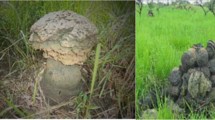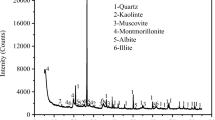Abstract
The geotechnical properties and microstructures of lime-stabilized silt clay from Jilin province, China, were studied in detail. Laboratory tests were conducted to evaluate the effects of lime content and curing time on the overall soil properties, including compaction characteristics, Atterberg limits, particle size distribution, pH, stress–strain behavior, peak strength, shear strength parameters, and California bearing ratio (CBR). The stabilized mechanisms of lime in silt clay were examined, and the observed test results were explained based on the results of scanning electron microscropy (SEM) and X-ray diffraction analyses of the specimens. Lime content and curing duration significantly influenced the geotechnical properties and microstructure of the lime-stabilized silt clay specimens. An increase in lime content resulted in increases in compaction water content, liquid limit, plastic limit, sand size-fractions, pH, peak strength, cohesion, internal friction angle, and the CBR, but led to a reduction in the plasticity index, silt fractions, clay fractions, swelling capacity, and water absorption. Also, the addition of lime to silt clay changed this soil type from a ductile to a brittle material. The optimum lime content of the silt clays from Jilin province was determined to be approximately 5–7%. SEM micrographs showed that a white cementitious gel was formed after the addition of lime and that peaks related to smectite, illite, kaolinite, and quartz appeared to be sharper after stabilization with lime and a 90-day period of curing. These results show that the geotechnical properties of lime-stabilized silt clay are affected by the microstructural organization of the silt clay itself.











Similar content being viewed by others
References
Aldaood A, Bouasker M, Al-Mukhtar M (2014) Geotechnical properties of lime-treated gypseous soils. Appl Clay Sci 88–89(3):39–48
Al-Rawas AA, Goosen MFA (2006) Expansive soils: recent advances in characterization and treatment. Taylor & Francis group/Balkema, London
Boardman DI, Glendinning S, Rogers CDF (2001) Development of stabilisation and solidification in lime-clay mixes. Geotechnique 51(6):533–544
Cuisinier O, Auriol JC, Borgne TL et al (2011) Microstructure and hydraulic conductivity of a compacted lime-treated soil. Eng Geol 123(3):187–193
Eades JL, Grim RE (1960) Reaction of hydrated lime with pure clay minerals in soil stabilization. Highw Res Board Bull 262:51–63
Hebib S, Farrell ER (2003) Some experiences on the stabilization of Irish peats. Can Geotech J 40(1):107–120
Herrin M, Mitchell H (1961) “Lime–soil mixtures.” Bulletin No. 304. Highway Research Board, Washington DC
Ingles OG, Metcalf JB (1972) Soil stabilization: principles and practice. Butterworths, Sidney
Jha AK, Sivapullaiah PV (2015) Mechanism of improvement in the strength and volume change behavior of lime stabilized soil. Eng Geol 198(2):53–64
Li X, Zhang LM (2009) Characterization of dual-structure pore-size distribution of soil. Can Geotech J 46(46):129–141
Liu P (2003) Test and study into strengthening technique of overwet and high liquid limit soil subbase. Munic Eng Technol 21(2):97–102
Lo SR, Wardani SP (2002) Strength and dilatancy of a silt stabilized by a cement and fly ash mi. Can Geotech J 39(1):77–89
Locat J, Bérubé MA, Choquette M (1990) Laboratory investigations on the lime stabilization of sensitive clays. Can Geotech J 27(3):294–304
Mathew PK, Rao SN (1997) Effect of lime on cation exchange capacity of marine clay. J Geotech Geoenviron Eng 123(2):183–185
Nalbantoglu Z, Gucbilmez E (2001) Improvement of calcareous expansive soils in semi-arid environments. J Arid Environ 47(4):453–463
National Lime Association (NLA) (2004) Lime-treated soil construction manual lime stabilization & lime modification. Technical brief. National Lime Association, Arlington
Pomakhina E, Deneele D, Gaillot AC et al (2012) 29 Si solid state NMR investigation of pozzolanic reaction occurring in lime-treated ca-bentonite. Cem Concr Res 42(4):626–632
Puppala AJ, Griffin JA, Hoyos LR et al (2004) Studies on sulfate-resistant cement stabilization methods to address sulfate-induced soil heave. J Geotech Geoenviron Eng 130(4):391–402
Rahardjo H, Santoso VA, Leong EC et al (2013) Use of recycled crushed concrete and Secudrain in capillary barriers for slope stabilization. Can Geotech J 50(6):662–673
Runigo BL, Ferber V, Cui YJ et al (2011) Performance of lime-treated silty soil under long-term hydraulic conditions. Eng Geol 118(1–2):20–28
Sariosseiri F, Muhunthan B (2009) Effect of cement treatment on geotechnical properties of some Washington state soils. Eng Geol 104(1):119–125
Sharma NK, Swain SK, Sahoo UC (2012) Stabilization of a clayey soil with fly ash and lime: a micro level investigation. Geotech Geol Eng 30(5):1197–1205
Wilkinson A, Haque A, Kodikara J, Adamson J, Christie D (2010) Improvement of problematic soils by lime slurry pressure injection: case study. J Geotech Geoenviron Eng 136(10):1459–1468
Zhan GF, Zhang Q, Fu Z et al (2015) Research on influence of freeze-thaw cycles on static strength of lime-treated silty clay. Rock Soil Mech 36:351–356
Acknowledgements
This research is financially supported by the project of Education Department of Jilin Province (JJKH20170260KJ), the Project of Ministry of Housing and Urban-Rural Development (2017-K4-004), and the Plan Projects of Transportation Science and Technology in Jilin Province of China (2011103).
Author information
Authors and Affiliations
Corresponding author
Ethics declarations
Conflict of interests
The authors declare that there are no conflicts of interest regarding the publication of this paper.
Rights and permissions
About this article
Cite this article
Zhu, F., Li, Z., Dong, W. et al. Geotechnical properties and microstructure of lime-stabilized silt clay. Bull Eng Geol Environ 78, 2345–2354 (2019). https://doi.org/10.1007/s10064-018-1307-5
Received:
Accepted:
Published:
Issue Date:
DOI: https://doi.org/10.1007/s10064-018-1307-5




